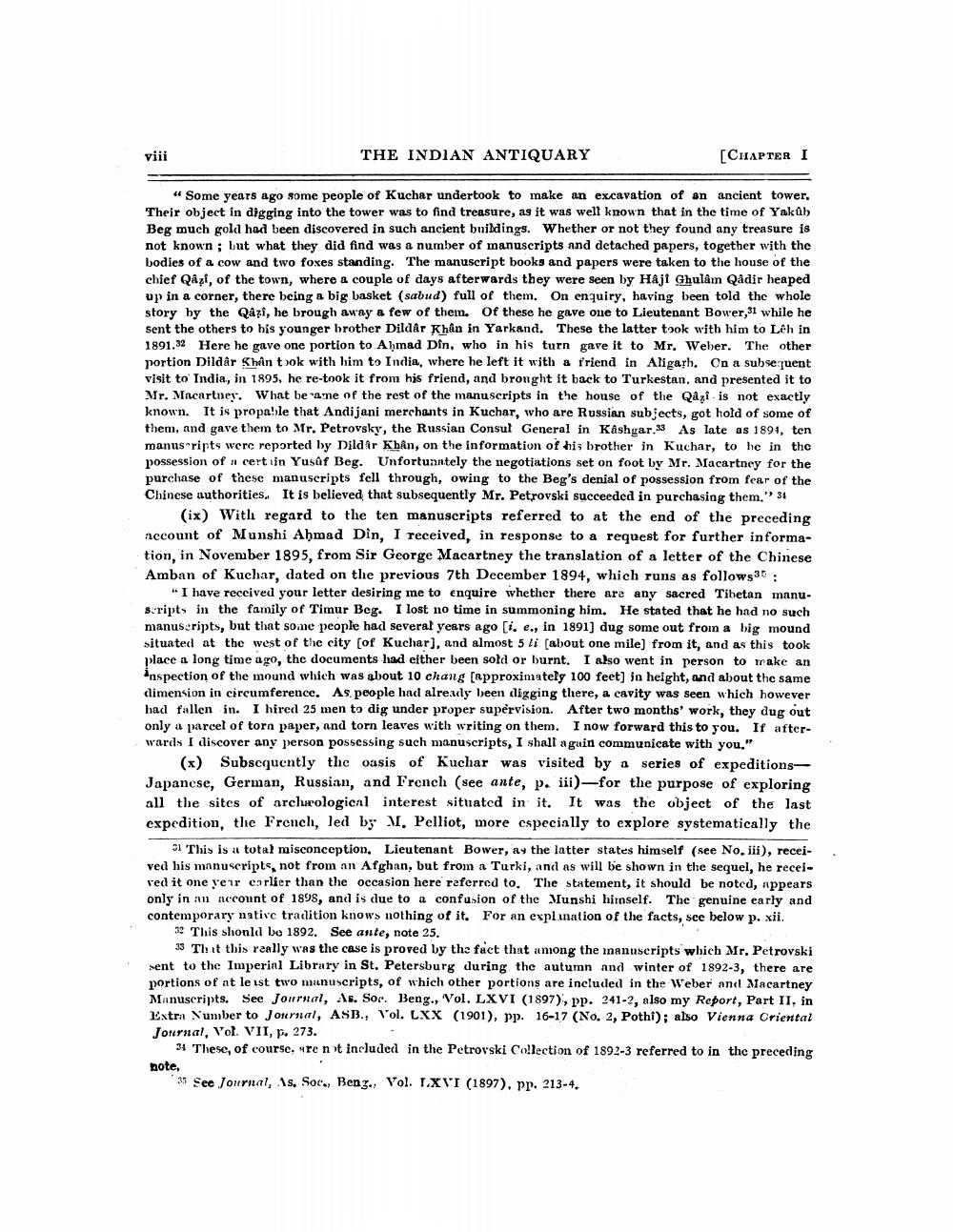________________
THE INDIAN ANTIQUARY
[CHAPTER I
"Some years ago some people of Kuchar undertook to make an excavation of an ancient tower. Their object in digging into the tower was to find treasure, as it was well known that in the time of Yakub Beg much gold had been discovered in such ancient buildings. Whether or not they found any treasure is not known; but what they did find was a number of manuscripts and detached papers, together with the bodies of a cow and two foxes standing. The manuscript books and papers were taken to the house of the chief Qazi, of the town, where a couple of days afterwards they were seen by Hâjl Ghulâm Qâdir heaped up in a corner, there being a big basket (sabud) full of them. On enquiry, having been told the whole story by the Qazi, he brough away a few of them. Of these he gave one to Lieutenant Bower,31 while he sent the others to his younger brother Dildar Khân in Yarkand. These the latter took with him to Lêh in 1891.32 Here he gave one portion to Ahmad Din, who in his turn gave it to Mr. Weber. The other portion Dildar Khan took with him to India, where he left it with a friend in Aligarh. On a subsequent visit to India, in 1895, he re-took it from his friend, and brought it back to Turkestan, and presented it to Mr. Macartney. What beame of the rest of the manuscripts in the house of the Qazi is not exactly known. It is propable that Andijani merchants in Kuchar, who are Russian subjects, got hold of some of them, and gave them to Mr. Petrovsky, the Russian Consul General in Kashgar.33 As late as 1894, ten manuscripts were reported by Dildar Khân, on the information of his brother in Kuchar, to he in the possession of a cert in Yusuf Beg. Unfortunately the negotiations set on foot by Mr. Macartney for the purchase of these manuscripts fell through, owing to the Beg's denial of possession from fear of the Chinese authorities. It is believed that subsequently Mr. Petrovski succeeded in purchasing them." 31
viii
(ix) With regard to the ten manuscripts referred to at the end of the preceding account of Munshi Ahmad Din, I received, in response to a request for further information, in November 1895, from Sir George Macartney the translation of a letter of the Chinese Amban of Kuchar, dated on the previous 7th December 1894, which runs as follows 35:
"I have received your letter desiring me to enquire whether there are any sacred Tibetan manuscripts in the family of Timur Beg. I lost no time in summoning him. He stated that he had no such manuscripts, but that some people had several years ago [i. e., in 1891] dug some out from a big mound situated at the west of the city [of Kuchar], and almost 5 li [about one mile] from it, and as this took place a long time ago, the documents had either been sold or burnt. I also went in person to make an inspection of the mound which was about 10 chang [approximately 100 feet] in height, and about the same dimension in circumference. As people had already been digging there, a cavity was seen which however had fallen in. I hired 25 men to dig under proper supervision. After two months' work, they dug out only a parcel of torn paper, and torn leaves with writing on them. I now forward this to you. If afterwards I discover any person possessing such manuscripts, I shall again communicate with you."
(x) Subsequently the oasis of Kuchar was visited by a series of expeditionsJapanese, German, Russian, and French (see ante, p. iii)-for the purpose of exploring all the sites of archeological interest situated in it. It was the object of the last expedition, the French, led by M. Pelliot, more especially to explore systematically the
31 This is a total misconception, Lieutenant Bower, as the latter states himself (see No. iii), received his manuscripts, not from an Afghan, but from a Turki, and as will be shown in the sequel, he received it one year earlier than the occasion here referred to. The statement, it should be noted, appears only in an account of 1898, and is due to a confusion of the Munshi himself. The genuine early and contemporary native tradition knows nothing of it. For an explanation of the facts, see below p. xii.
32 This should be 1892. See ante, note 25.
33 That this really was the case is proved by the fact that among the manuscripts which Mr. Petrovski sent to the Imperial Library in St. Petersburg during the autumn and winter of 1892-3, there are portions of at least two manuscripts, of which other portions are included in the Weber and Macartney Manuscripts. See Journal, As. Soc. Beng., Vol. LXVI (1897), pp. 241-2, also my Report, Part II, in Extra Number to Journal, ASB., Vol. LXX (1901), pp. 16-17 (No. 2, Pothi); also Vienna Criental Journal, Vol. VII, p. 273.
34 These, of course, are not included in the Petrovski Collection of 1892-3 referred to in the preceding
note,
35 See Journal, As, Soc., Beng., Vol. LXVI (1897), pp. 213-4.




